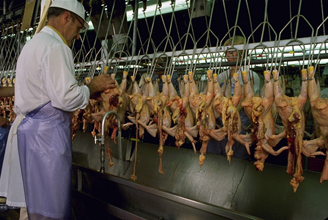|
Occurrence is worldwide. The incidence rate of infection is highest among infants and young children. Epidemics in hospitals, institutions for children, restaurants, nursing homes and the community are common and usually arise from food (meat, poultry, uncooked or lightly cooked eggs and egg products, raw milk and dairy products) contaminated at source or during handling by an ill person or carrier. In the United States in 1994, an estimated 224,000 people came down with salmonella poisoning after eating ice cream.
Over 350 people were taken ill in the UK during six outbreaks of salmonella poisoning in autumn 2002 and two people died in the North West of England, according to the Food Standards Agency. In the past, the emphasis has been put on good hygiene procedures to protect people rather than attempt to eradicate the incidence in the animal population. Campylobacter bacteria is another food bourne infection that causes similar affects to salmonella. The bacteria are found naturally in a chicken's gut, but only some strains are harmful. Organic procedures do not protect against salmonella or campylobacter.
Salmonella is a bacteria usually found in poultry, eggs, unprocessed milk and in meat and water. Symptoms of salmonella poisoning appear 12-48 hours after consumption of contaminated food or beverages. Symptoms include sudden onset of headache, abdominal pain, diarrhea, nausea and sometimes vomiting. |
© 2003 EP@W Publishing Co Ltd
Photos courtesy of http://www.usda.gov

